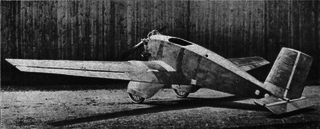
The Messerschmitt Me 309 was a prototype German fighter, designed in the early years of World War II to replace the Messerschmitt Bf 109. Although it had many advanced features, the Me 309's performance left much to be desired and it had so many problems that the project was cancelled with only four prototypes built. The Me 309 was one of two failed Messerschmitt projects intended to replace the Bf 109, the other being the 1943 Me 209 project.

The Albatros G.III, was a German bomber aircraft development of World War I. It was a large, single-bay biplane of unequal span and unstaggered wings. Power was provided by two Benz Bz.IVa pusher engines installed in nacelles carried between the wings. An unusual feature of the design was that the lower wing was provided with cutouts for the propellers, allowing the engine nacelles to be mounted further forward than would have been otherwise possible. Few were built, these seeing service mostly on the Macedonian Front in 1917.
The Albatros L 58 was a German airliner of the 1920s. It was a single-engine cantilever monoplane which accommodated the pilot in an open cockpit at the top of the fuselage, and seated five-six passengers within it.

The Albatros L 59 was a single-seat German utility aircraft of the 1920s. It was a single-engine low-wing cantilever monoplane with large, spatted wide track undercarriage attached, unusually for the time not to the fuselage but to the wing roots. The whole aircraft was covered in 3-ply.
The Albatros L 60 was a two-seat German utility aircraft of the 1920s developed from the Albatros L 59. It was a single-engine low-wing cantilever monoplane with large, spatted undercarriage.

The Albatros L 68 Alauda was a two-seat German trainer aircraft of the 1920s. It was a single-engine biplane of conventional configuration that seated the pilot and instructor in tandem, open cockpits. The wings were of unequal span and had a pronounced stagger.

The Albatros L 69 was a two-seat German parasol monoplane racing and training aircraft of 1925. It was a single-engine parasol-wing monoplane of conventional configuration that seated the pilot and passenger in tandem, open cockpits. It was advertised as a trainer, however contemporary reports dismissed this due to the difficulty in accessing the front cockpit, and the designers' focus on performance.

The Albatros L 72 was a German transport aircraft of the 1920s, designed to carry newspapers between German cities for Ullstein Verlag. A single revised example was built for the Hamburger Fremdenblatt.

The Albatros L 73 was a German twin-engined biplane airliner of the 1920s. Of conventional configuration, it featured a streamlined, boat-like fuselage and engine nacelles. All four manufactured aircraft of that type were operated by Deutsche Luft Hansa, one of which crashed near Babekuhl on 28 May 1928.

The Albatros L 75 Ass was a German trainer biplane of the 1920s. Of conventional configuration, it seated the pilot and instructor in separate, open cockpits. The wings were single-bay, equal-span, and had a slight stagger. Production continued after Albatros was absorbed by Focke-Wulf.
The Albatros L 79 Kobold was a single-seat German aerobatic aircraft of the 1920s and 1930s. It was a single-bay biplane with unstaggered, equal-span wings that had a symmetrical airfoil intended to ensure performance during inverted flight.

The Albatros L 100 was a light aircraft built in Germany to compete in the Europarundflug air race. It was a low-wing braced monoplane of conventional taildragger configuration.

After the success of the 1940 airborne assaults involving the DFS 230, the Reichsluftfahrtministerium invited the Deutsche Forschungsanstalt für Segelflug/DFS and Gotha to submit plans for a larger capacity glider. The result was the DFS 231, a twenty-seat troop designed by Hans Jacobs, who had previously produced the successful, nine seat DFS 230.

The Heinkel HD 42 50, later designated the Heinkel He 42 was a German two-seat biplane seaplane originally designed for the Deutsche Verkehrsfliegerschule, and later built for the German Luftwaffe. The aircraft was used until the end of World War II as a trainer for maritime pilots.

The Gotha Go 149 was a military aircraft developed in Germany in the mid-1930s for training fighter pilots. It was a conventional low-wing cantilever monoplane with tailwheel undercarriage, the main units of which retracted inwards. The wing was wooden, while the monocoque fuselage was metal. Two prototypes were constructed, and an armed version was also proposed as a light home-defence fighter (Heimatschutzjäger) armed with two 7.92 mm (.312 in) MG 17 machine guns, but the Luftwaffe did not purchase either version of the design, and no further examples were built.

The Arado Ar 77 was a German twin-engined monoplane, designed as an advanced training aircraft from 1934.

The Fieseler Fi 99 Jungtiger was a German sports aircraft prototype, produced by Fieseler company. The aircraft was a low-wing two-seat aircraft with an enclosed cabin. It was powered by a Hirth HM 506A engine, producing 160 hp (119 kW).

The Albatros L102 / Albatros Al 102, was a German trainer aircraft of the 1930s. It was a parasol-wing landplane, seating the student pilot and instructor in separate, open cockpits. A biplane floatplane version was also built as the Al 102W, with strut-braced lower wings.
The Albatros L 103 / Albatros Al 103 was a German experimental aircraft of the 1930s. It was a parasol-wing landplane of conventional configuration, seating the pilot and flight test observer in separate, open cockpits. The Al 103 was used to test variations in sweepback, dihedral and tailplane area.
The Gotha Go 241 was a low-wing twin-engined four-seat transport aircraft manufactured by Gothaer Waggonfabrik in the early 1940s and intended for the general aviation market.















